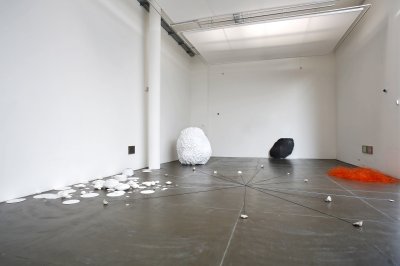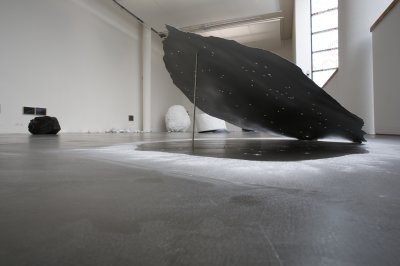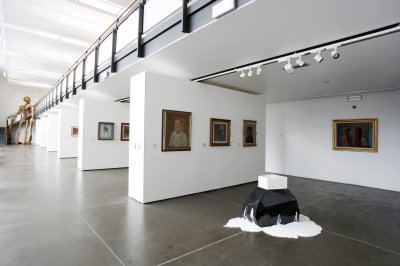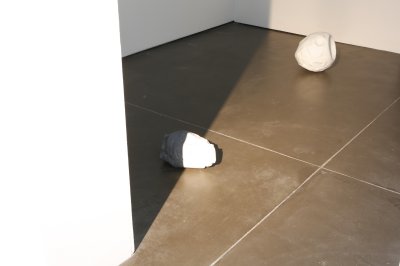Gianni Caravaggio
Finalmente Solo/ Enfin Seul
 31 October 2014–11 January 2015
31 October 2014–11 January 2015
The Exhibition
As far as Gianni caravaggio is concerned, it is all about giving art meaning, restoring its function as thought, as the “originating cause,” as he likes to say. His artistic conscience leads him to constant critical and dialectic reflection about art, the limitations of the system and how to overcome them, and the profound significance that every thought, every action, every study ought to have.
Too severe to accept the clichés of history and memory, Gianni caravaggio spends most of his time as an artist and teacher ana- lysing the language of art itself, filtering it and making it into the expression of a sharp, cutting way of thinking about art (and therefore the world).
Gianni sees conventions as mortal enemies to be boldly rejected and fought to the death: everything in his work, in his artistic practice, leads toward a concept of an image, the image created by the artist, which is a priori human: an original seed which over- comes fads, habits, and the everyday.
Gianni’s works do not represent or narrate, but they are, they exist, in all their clarity and apparent simplicity. This is why one of the principal aesthetic results of his creative practice is inten- sification of the evocative capacity of constellations of materials. They should be viewed as isolated, enigmatic points, irritating for- eign bodies, unidentifiable species and, at the same time, spiritual centres forming the context of a vast, intelligible, vital, real in- terconnection of different systems and models of thought. it is precisely this vitality and emotionality that generate the aura of empathy that surrounds caravaggio’s works and helps the viewer internalise his poetics and participate in them in his imagination. caravaggio always manages to set up a silent dialogue with the viewer, supported not by creation of amazing images but by an emotional and intellectual tension that leads to meditation, to inner silence, to concentration and to constant reflection on the meaning of our existence, on fragments of images, emotions and landscapes that we bring with us.
Alone at last is the title Gianni gives these two complementary exhibitions through which we can enter right into his artistic ca- reer since the early 1990s. and we know well how important and evocative the titles of his works and exhibitions are for caravag- gio, as a way of verbalising the very act of creation.
But is Alone at Last a hope for the artist, or an invitation to the viewer? is it the artist who wishes to be alone with himself, far re- moved from noise, stress and demands, concentrated on his work, free to capture an image, a flash, a creative inspiration for devel- opment? or is it the artist who invites the public to leave ‘outside’ the thousand audiovisual stimuli with which we are bombarded, the real time connections, the anxiety of being everywhere all the time, to go back to reflecting, to feeling with our bodies and minds the works that he himself has ‘staged’ for us? caravaggio asks us to go into his ‘magic circle,’ to free ourselves of conven- tions, of everyday life, and to view things with amazement, ready to use our imaginations, “just as, when a plane passes above the clouds, we imagine we can see other suns shining onto distant earths,” as Jean-Luc nancy writes so poetically for this exhibition. caravaggio’s universes transmit constant vibrations which the public is invited to feel and grasp by implementing ever-changing processes of recognition. all Gianni caravaggio’s plastic works do in fact contrast latently but intensely with our ability to orient ourselves and our cognitive processes, which are based on the
way we see the universe, our perception of the real processes governing human and social relationships.
The fragmentary nature and general fragility of objects and the perishability of material assemblages convey a sensation of dis- tance, of ‘remoteness’ in time and space, linked with the search for possible contexts, centres and connections of significance. Melancholy disorientation, this sensation of existential isolation and interior travail of the various different components of the in- stallations, intensify the prospects of intelligible systems in which reason – the immanent human capacity to structure, organise and give concrete form to the universal constellations in the real human context – can unfold.
all Gianni caravaggio’s works therefore act constructively, as the artist seeks to restore spiritual energies in an entirely poetic form, conceiving of the work of art as a device for demiurgical acts capable of going back to the profound imagination every one of us has deep within us.
Gianni caravaggio’s exhibition is in fact the first, highly successful partnership between two important modern and contemporary art museums, in Saint-Étienne and in Gallarate, both of which have always paid great attention to today’s artistic creativity, with a special focus on italian art. caravaggio’s exhibition in Saint-Éti- enne follows, in fact, on a series of exhibitions of work by young italian artists, including Loris cecchini, Francesco Gennari, Sabri- na Mezzaqui, italo Zuffi, Marina Paris, Eva Marisaldi, and Stefano arienti, whose work emerged after the via degli ausoni genera- tion of roman artists, including Gianni Dessi, Pizzi cannella, nun- zio, and Marco Tirelli.
Simiarly, Ma*Ga in Gallarate exhibited and even produced site-specific works by artists of the same generation or younger, including Massimo Bartolini, Bianco-valente, Pierluigi calignano, alice cattaneo, Enrica Borghi, Ettore Favini, Luca vitone and Loris cecchini himself.
We are very happy with this new partnership between the two museums, the product of intense interaction free of all precon- ceived schemes and concerned primarily with providing strong, serious support for the latest new developments in art today.




